Application of sense relations to teaching English vocabulary
Vocabulary acquisition is central to language learning and of great importance to the English
Language Learners. Many learners face difficulty in correctly selecting words to deliver their
ideas due to their insufficient lexical knowledge. This work aims to analyze the significance
of sense relations instruction in vocabulary teaching. The author hopes to discuss a new path in
constructing and designing a variety of exercises and activities in sense relations in attempt to
promote learner’s English proficiency, especially vocabulary learning.

Trang 1
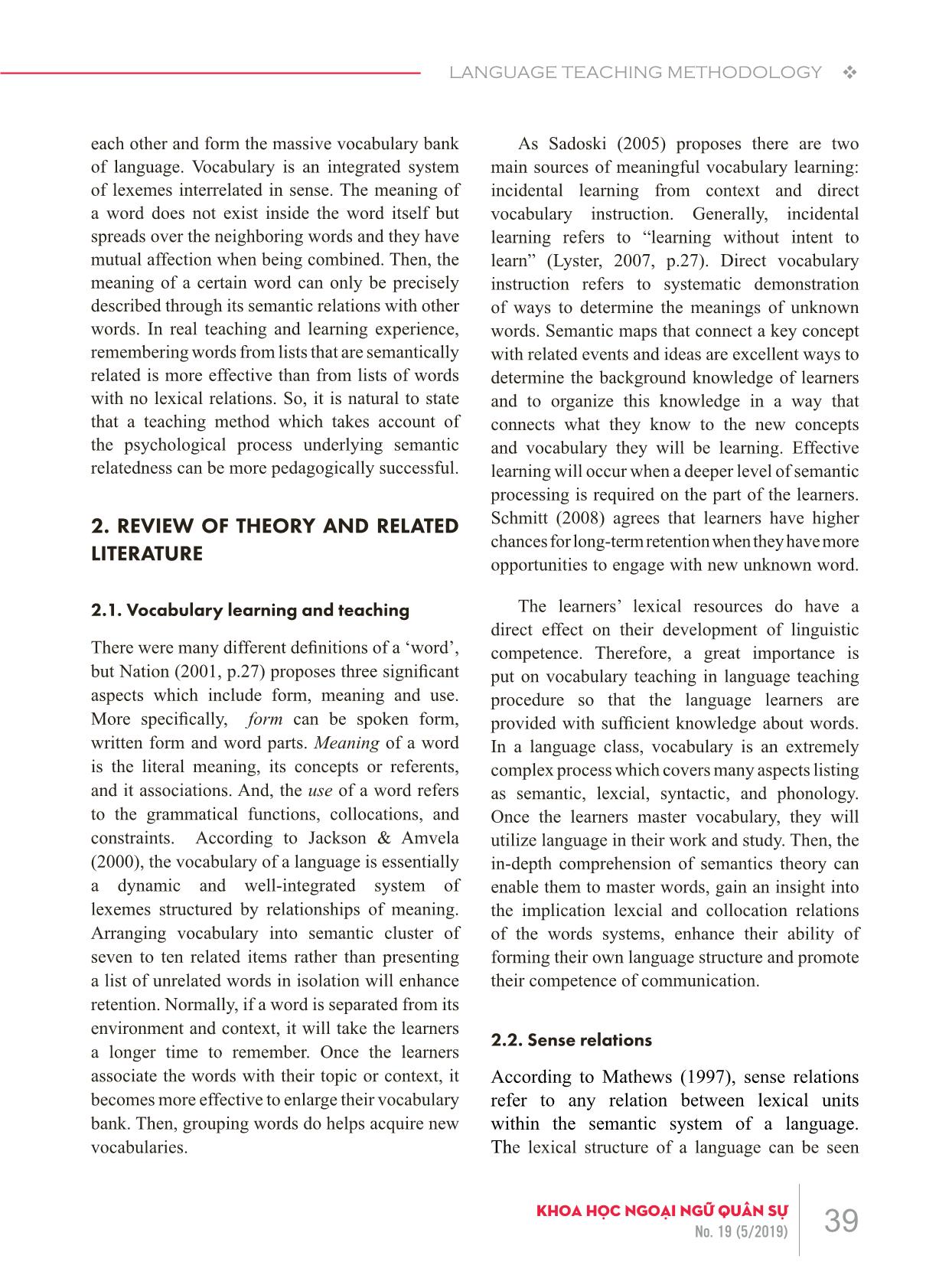
Trang 2
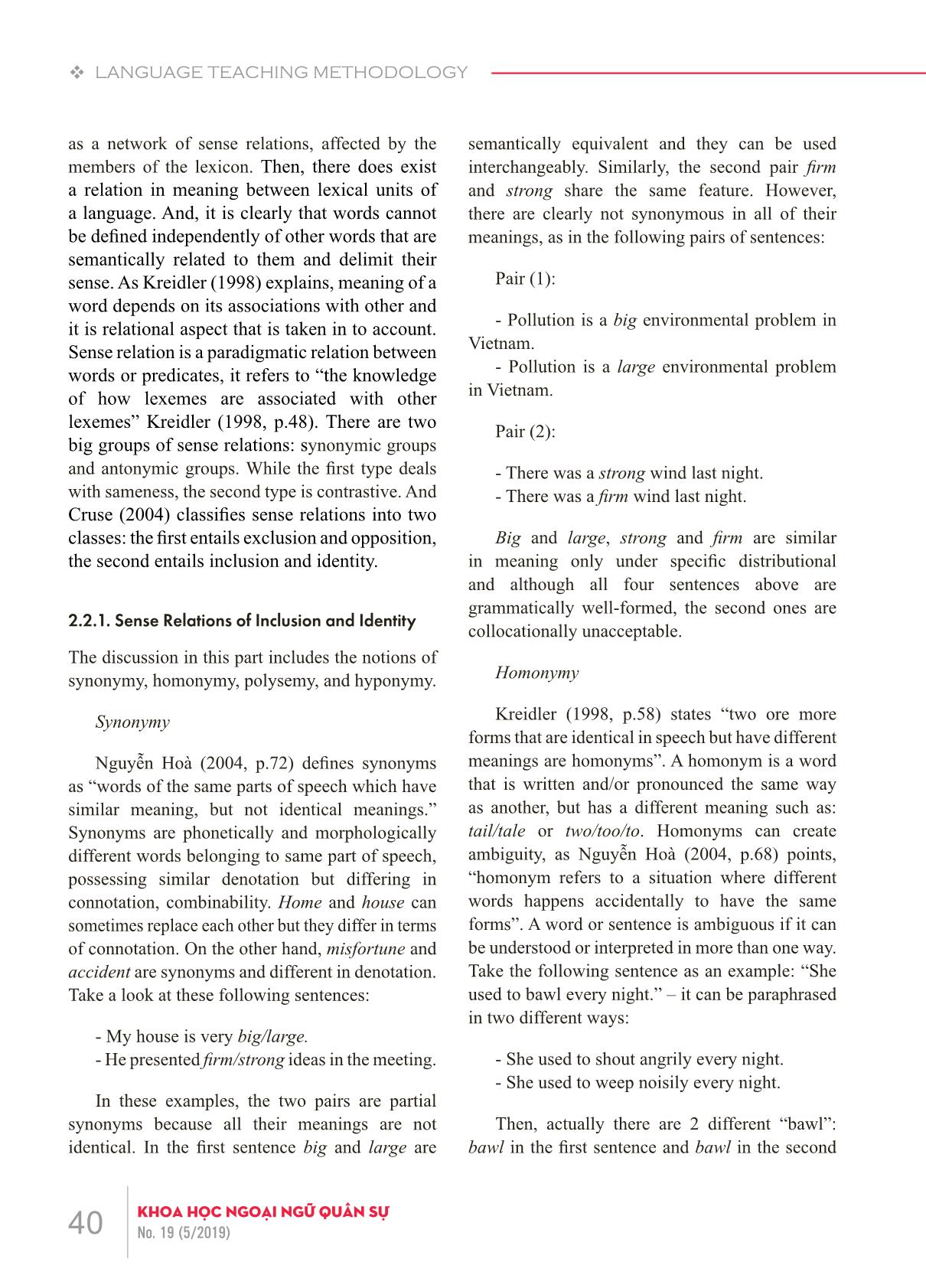
Trang 3
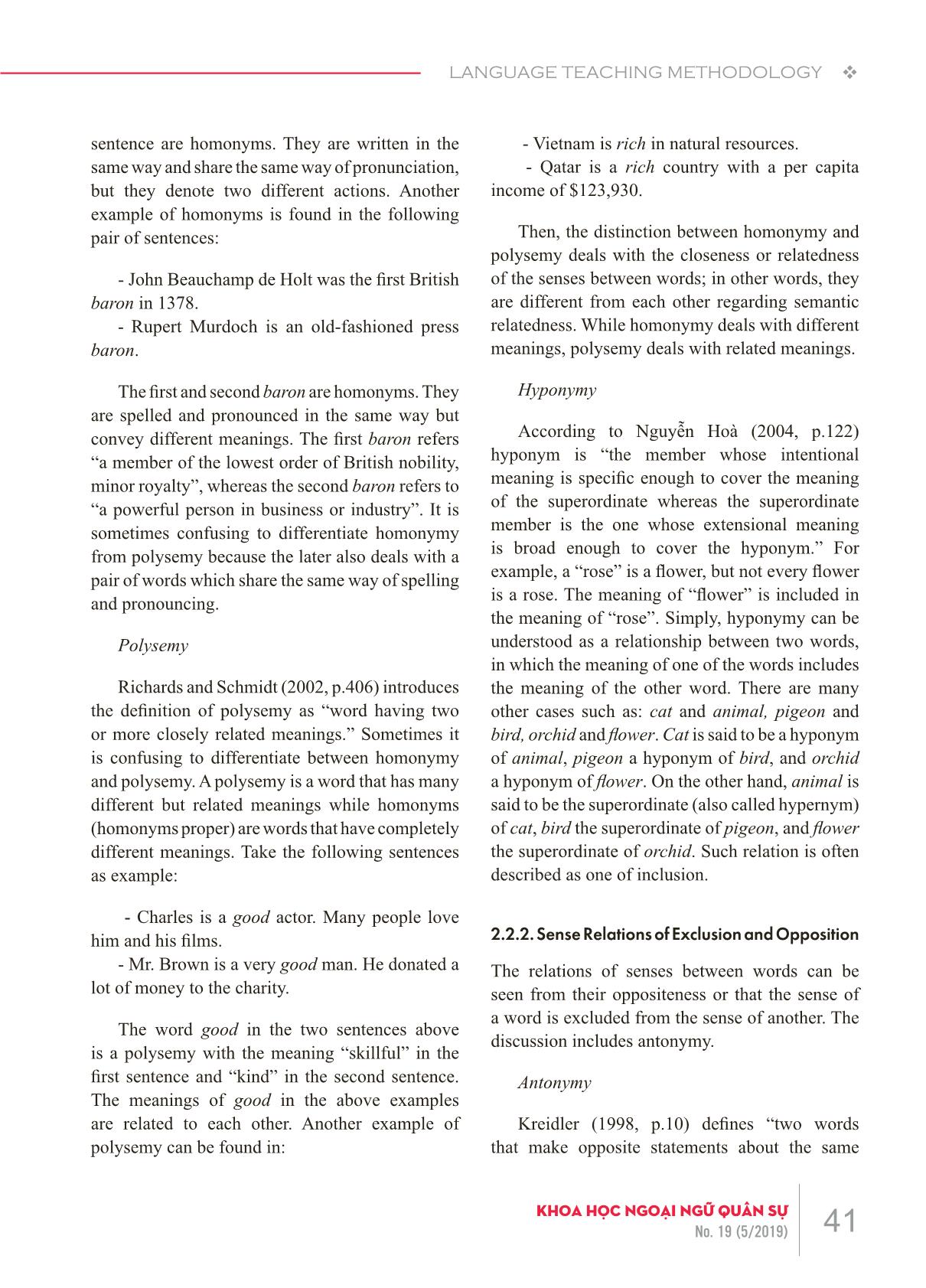
Trang 4
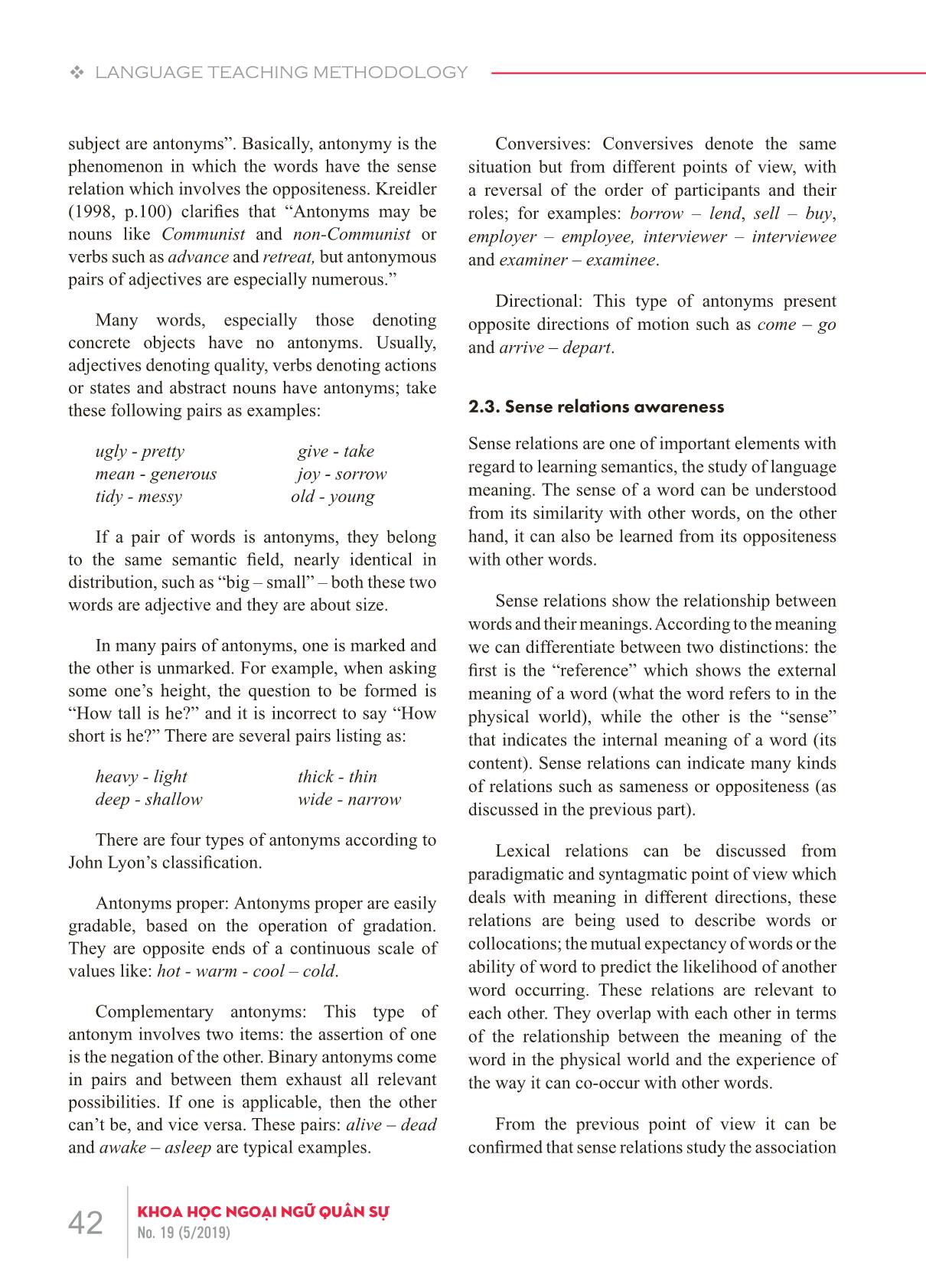
Trang 5
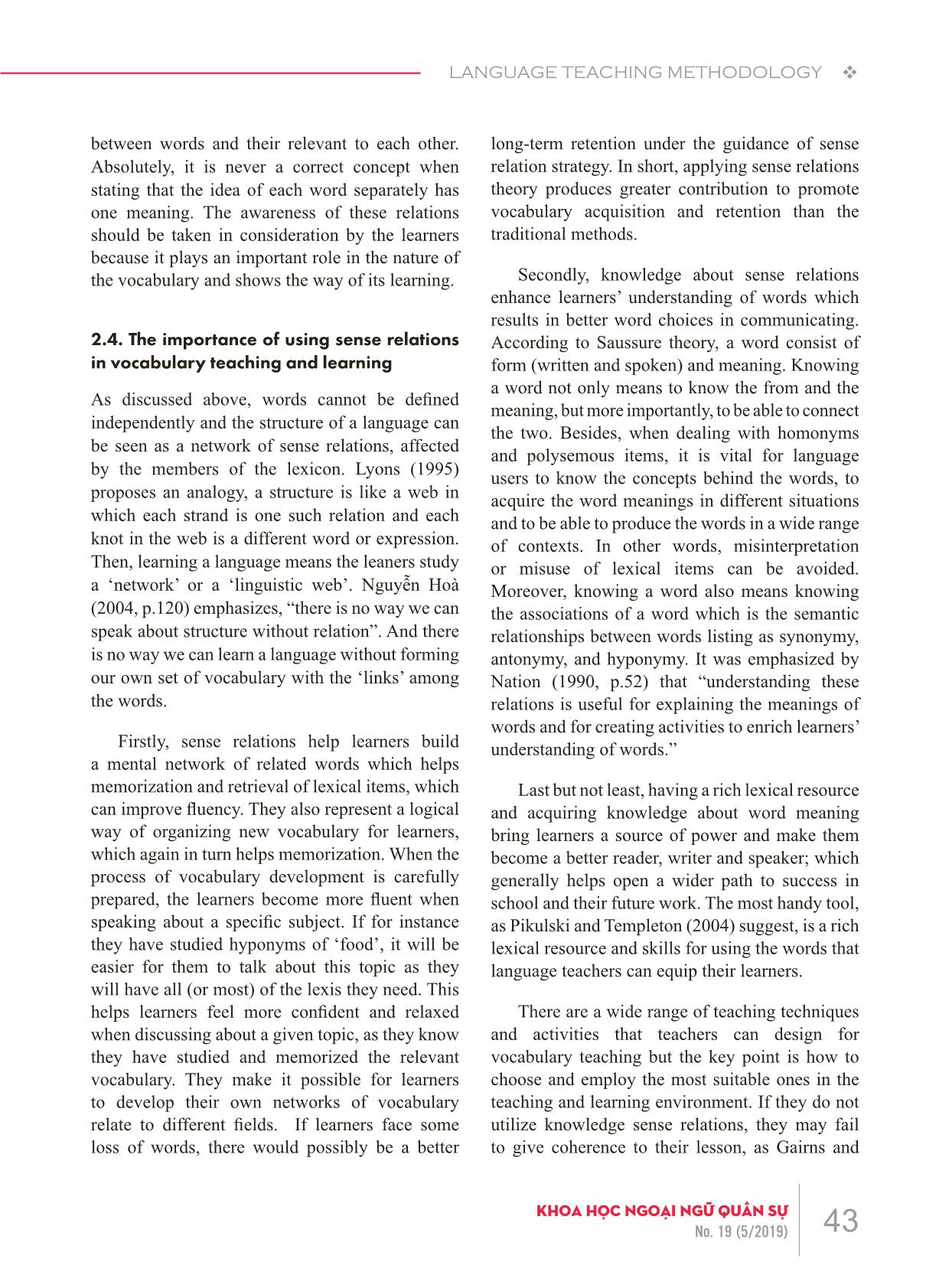
Trang 6
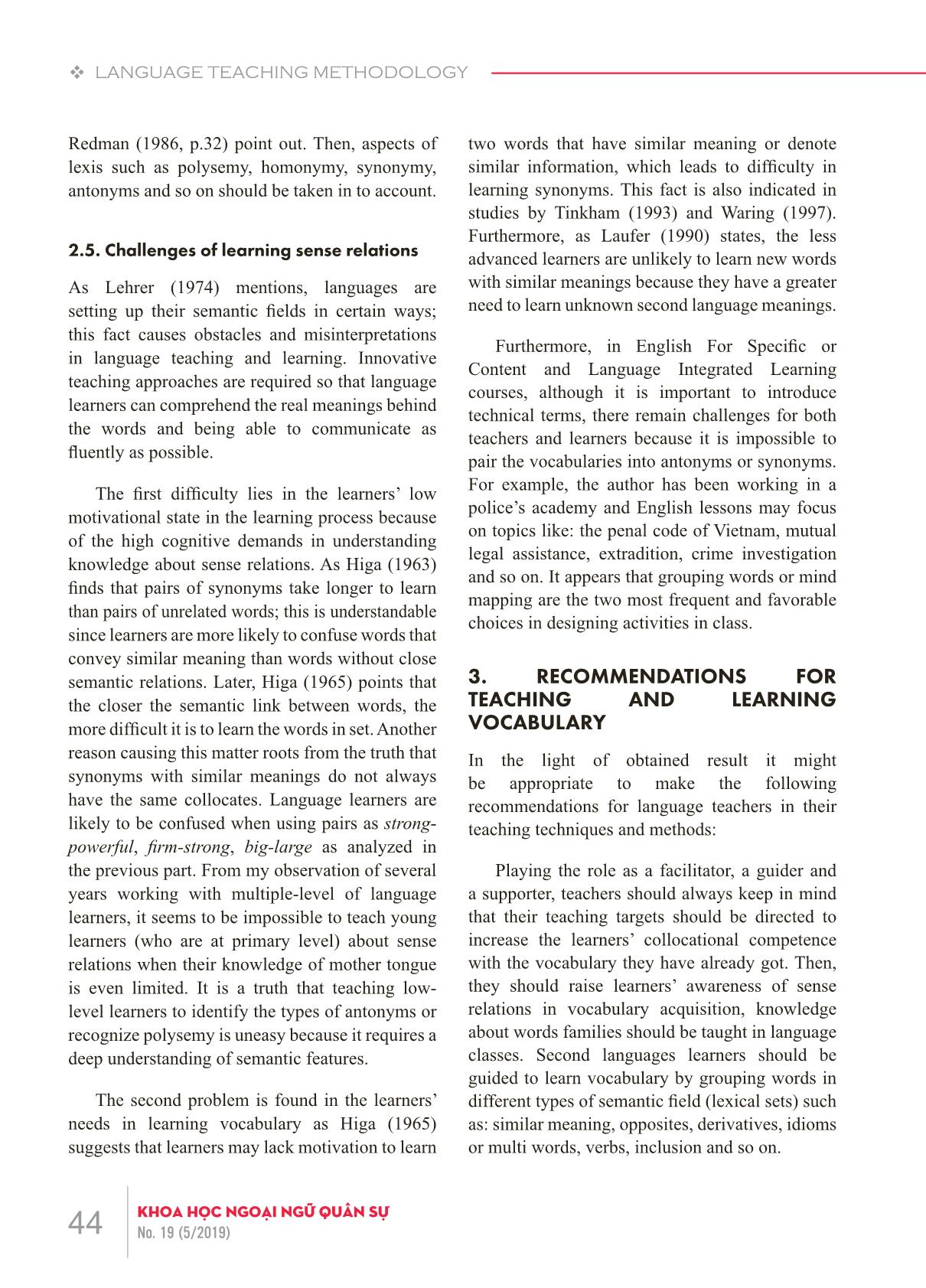
Trang 7
Bạn đang xem tài liệu "Application of sense relations to teaching English vocabulary", để tải tài liệu gốc về máy hãy click vào nút Download ở trên
Tóm tắt nội dung tài liệu: Application of sense relations to teaching English vocabulary
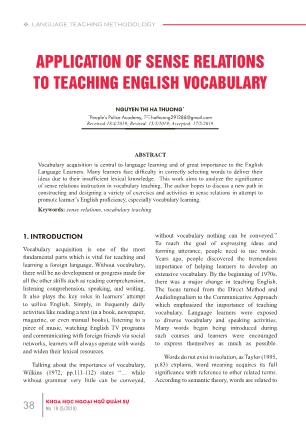
old-fashioned press baron. The first and second baron are homonyms. They are spelled and pronounced in the same way but convey different meanings. The first baron refers “a member of the lowest order of British nobility, minor royalty”, whereas the second baron refers to “a powerful person in business or industry”. It is sometimes confusing to differentiate homonymy from polysemy because the later also deals with a pair of words which share the same way of spelling and pronouncing. Polysemy Richards and Schmidt (2002, p.406) introduces the definition of polysemy as “word having two or more closely related meanings.” Sometimes it is confusing to differentiate between homonymy and polysemy. A polysemy is a word that has many different but related meanings while homonyms (homonyms proper) are words that have completely different meanings. Take the following sentences as example: - Charles is a good actor. Many people love him and his films. - Mr. Brown is a very good man. He donated a lot of money to the charity. The word good in the two sentences above is a polysemy with the meaning “skillful” in the first sentence and “kind” in the second sentence. The meanings of good in the above examples are related to each other. Another example of polysemy can be found in: - Vietnam is rich in natural resources. - Qatar is a rich country with a per capita income of $123,930. Then, the distinction between homonymy and polysemy deals with the closeness or relatedness of the senses between words; in other words, they are different from each other regarding semantic relatedness. While homonymy deals with different meanings, polysemy deals with related meanings. Hyponymy According to Nguyễn Hoà (2004, p.122) hyponym is “the member whose intentional meaning is specific enough to cover the meaning of the superordinate whereas the superordinate member is the one whose extensional meaning is broad enough to cover the hyponym.” For example, a “rose” is a flower, but not every flower is a rose. The meaning of “flower” is included in the meaning of “rose”. Simply, hyponymy can be understood as a relationship between two words, in which the meaning of one of the words includes the meaning of the other word. There are many other cases such as: cat and animal, pigeon and bird, orchid and flower. Cat is said to be a hyponym of animal, pigeon a hyponym of bird, and orchid a hyponym of flower. On the other hand, animal is said to be the superordinate (also called hypernym) of cat, bird the superordinate of pigeon, and flower the superordinate of orchid. Such relation is often described as one of inclusion. 2.2.2. Sense Relations of Exclusion and Opposition The relations of senses between words can be seen from their oppositeness or that the sense of a word is excluded from the sense of another. The discussion includes antonymy. Antonymy Kreidler (1998, p.10) defines “two words that make opposite statements about the same 42 KHOA HỌC NGOẠI NGỮ QUÂN SỰNo. 19 (5/2019) v LANGUAGE TEACHING METHODOLOGY subject are antonyms”. Basically, antonymy is the phenomenon in which the words have the sense relation which involves the oppositeness. Kreidler (1998, p.100) clarifies that “Antonyms may be nouns like Communist and non-Communist or verbs such as advance and retreat, but antonymous pairs of adjectives are especially numerous.” Many words, especially those denoting concrete objects have no antonyms. Usually, adjectives denoting quality, verbs denoting actions or states and abstract nouns have antonyms; take these following pairs as examples: ugly - pretty give - take mean - generous joy - sorrow tidy - messy old - young If a pair of words is antonyms, they belong to the same semantic field, nearly identical in distribution, such as “big – small” – both these two words are adjective and they are about size. In many pairs of antonyms, one is marked and the other is unmarked. For example, when asking some one’s height, the question to be formed is “How tall is he?” and it is incorrect to say “How short is he?” There are several pairs listing as: heavy - light thick - thin deep - shallow wide - narrow There are four types of antonyms according to John Lyon’s classification. Antonyms proper: Antonyms proper are easily gradable, based on the operation of gradation. They are opposite ends of a continuous scale of values like: hot - warm - cool – cold. Complementary antonyms: This type of antonym involves two items: the assertion of one is the negation of the other. Binary antonyms come in pairs and between them exhaust all relevant possibilities. If one is applicable, then the other can’t be, and vice versa. These pairs: alive – dead and awake – asleep are typical examples. Conversives: Conversives denote the same situation but from different points of view, with a reversal of the order of participants and their roles; for examples: borrow – lend, sell – buy, employer – employee, interviewer – interviewee and examiner – examinee. Directional: This type of antonyms present opposite directions of motion such as come – go and arrive – depart. 2.3. Sense relations awareness Sense relations are one of important elements with regard to learning semantics, the study of language meaning. The sense of a word can be understood from its similarity with other words, on the other hand, it can also be learned from its oppositeness with other words. Sense relations show the relationship between words and their meanings. According to the meaning we can differentiate between two distinctions: the first is the “reference” which shows the external meaning of a word (what the word refers to in the physical world), while the other is the “sense” that indicates the internal meaning of a word (its content). Sense relations can indicate many kinds of relations such as sameness or oppositeness (as discussed in the previous part). Lexical relations can be discussed from paradigmatic and syntagmatic point of view which deals with meaning in different directions, these relations are being used to describe words or collocations; the mutual expectancy of words or the ability of word to predict the likelihood of another word occurring. These relations are relevant to each other. They overlap with each other in terms of the relationship between the meaning of the word in the physical world and the experience of the way it can co-occur with other words. From the previous point of view it can be confirmed that sense relations study the association 43KHOA HỌC NGOẠI NGỮ QUÂN SỰNo. 19 (5/2019) LANGUAGE TEACHING METHODOLOGY v between words and their relevant to each other. Absolutely, it is never a correct concept when stating that the idea of each word separately has one meaning. The awareness of these relations should be taken in consideration by the learners because it plays an important role in the nature of the vocabulary and shows the way of its learning. 2.4. The importance of using sense relations in vocabulary teaching and learning As discussed above, words cannot be defined independently and the structure of a language can be seen as a network of sense relations, affected by the members of the lexicon. Lyons (1995) proposes an analogy, a structure is like a web in which each strand is one such relation and each knot in the web is a different word or expression. Then, learning a language means the leaners study a ‘network’ or a ‘linguistic web’. Nguyễn Hoà (2004, p.120) emphasizes, “there is no way we can speak about structure without relation”. And there is no way we can learn a language without forming our own set of vocabulary with the ‘links’ among the words. Firstly, sense relations help learners build a mental network of related words which helps memorization and retrieval of lexical items, which can improve fluency. They also represent a logical way of organizing new vocabulary for learners, which again in turn helps memorization. When the process of vocabulary development is carefully prepared, the learners become more fluent when speaking about a specific subject. If for instance they have studied hyponyms of ‘food’, it will be easier for them to talk about this topic as they will have all (or most) of the lexis they need. This helps learners feel more confident and relaxed when discussing about a given topic, as they know they have studied and memorized the relevant vocabulary. They make it possible for learners to develop their own networks of vocabulary relate to different fields. If learners face some loss of words, there would possibly be a better long-term retention under the guidance of sense relation strategy. In short, applying sense relations theory produces greater contribution to promote vocabulary acquisition and retention than the traditional methods. Secondly, knowledge about sense relations enhance learners’ understanding of words which results in better word choices in communicating. According to Saussure theory, a word consist of form (written and spoken) and meaning. Knowing a word not only means to know the from and the meaning, but more importantly, to be able to connect the two. Besides, when dealing with homonyms and polysemous items, it is vital for language users to know the concepts behind the words, to acquire the word meanings in different situations and to be able to produce the words in a wide range of contexts. In other words, misinterpretation or misuse of lexical items can be avoided. Moreover, knowing a word also means knowing the associations of a word which is the semantic relationships between words listing as synonymy, antonymy, and hyponymy. It was emphasized by Nation (1990, p.52) that “understanding these relations is useful for explaining the meanings of words and for creating activities to enrich learners’ understanding of words.” Last but not least, having a rich lexical resource and acquiring knowledge about word meaning bring learners a source of power and make them become a better reader, writer and speaker; which generally helps open a wider path to success in school and their future work. The most handy tool, as Pikulski and Templeton (2004) suggest, is a rich lexical resource and skills for using the words that language teachers can equip their learners. There are a wide range of teaching techniques and activities that teachers can design for vocabulary teaching but the key point is how to choose and employ the most suitable ones in the teaching and learning environment. If they do not utilize knowledge sense relations, they may fail to give coherence to their lesson, as Gairns and 44 KHOA HỌC NGOẠI NGỮ QUÂN SỰNo. 19 (5/2019) v LANGUAGE TEACHING METHODOLOGY Redman (1986, p.32) point out. Then, aspects of lexis such as polysemy, homonymy, synonymy, antonyms and so on should be taken in to account. 2.5. Challenges of learning sense relations As Lehrer (1974) mentions, languages are setting up their semantic fields in certain ways; this fact causes obstacles and misinterpretations in language teaching and learning. Innovative teaching approaches are required so that language learners can comprehend the real meanings behind the words and being able to communicate as fluently as possible. The first difficulty lies in the learners’ low motivational state in the learning process because of the high cognitive demands in understanding knowledge about sense relations. As Higa (1963) finds that pairs of synonyms take longer to learn than pairs of unrelated words; this is understandable since learners are more likely to confuse words that convey similar meaning than words without close semantic relations. Later, Higa (1965) points that the closer the semantic link between words, the more difficult it is to learn the words in set. Another reason causing this matter roots from the truth that synonyms with similar meanings do not always have the same collocates. Language learners are likely to be confused when using pairs as strong- powerful, firm-strong, big-large as analyzed in the previous part. From my observation of several years working with multiple-level of language learners, it seems to be impossible to teach young learners (who are at primary level) about sense relations when their knowledge of mother tongue is even limited. It is a truth that teaching low- level learners to identify the types of antonyms or recognize polysemy is uneasy because it requires a deep understanding of semantic features. The second problem is found in the learners’ needs in learning vocabulary as Higa (1965) suggests that learners may lack motivation to learn two words that have similar meaning or denote similar information, which leads to difficulty in learning synonyms. This fact is also indicated in studies by Tinkham (1993) and Waring (1997). Furthermore, as Laufer (1990) states, the less advanced learners are unlikely to learn new words with similar meanings because they have a greater need to learn unknown second language meanings. Furthermore, in English For Specific or Content and Language Integrated Learning courses, although it is important to introduce technical terms, there remain challenges for both teachers and learners because it is impossible to pair the vocabularies into antonyms or synonyms. For example, the author has been working in a police’s academy and English lessons may focus on topics like: the penal code of Vietnam, mutual legal assistance, extradition, crime investigation and so on. It appears that grouping words or mind mapping are the two most frequent and favorable choices in designing activities in class. 3. RECOMMENDATIONS FOR TEACHING AND LEARNING VOCABULARY In the light of obtained result it might be appropriate to make the following recommendations for language teachers in their teaching techniques and methods: Playing the role as a facilitator, a guider and a supporter, teachers should always keep in mind that their teaching targets should be directed to increase the learners’ collocational competence with the vocabulary they have already got. Then, they should raise learners’ awareness of sense relations in vocabulary acquisition, knowledge about words families should be taught in language classes. Second languages learners should be guided to learn vocabulary by grouping words in different types of semantic field (lexical sets) such as: similar meaning, opposites, derivatives, idioms or multi words, verbs, inclusion and so on.
File đính kèm:
 application_of_sense_relations_to_teaching_english_vocabular.pdf
application_of_sense_relations_to_teaching_english_vocabular.pdf

